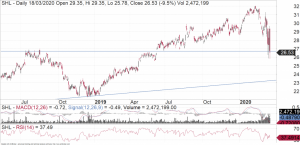The share price of Sonic Healthcare (ASX:SHL) has not been immune to the recent market sell-off. However, they have outperformed the S&P/ASX 200 Index as well as the S&P/ASX Healthcare over the past three weeks.
As one of the leading global providers of pathology/clinical laboratory services, we examine the extent to which SHL’s earnings are leveraged to increased patient testing for coronavirus (COVID-19). While the latter has the potential to be an earnings tailwind, we also assess the performance of the underlying business in order to provide a more complete picture of the Company’s fundamentals.
About Sonic Healthcare
Sonic Healthcare provides highly specialised pathology/clinical laboratory and diagnostic imaging services to clinicians (GPs and specialists), hospitals, community health services, and their patients. The Company is the world’s third largest provider of pathology/clinical laboratory services. It has strong positions in the laboratory markets of eight countries, being the largest private operator in Australia, Germany, Switzerland and the UK.
Approximately 80% of SHL’s revenue is earned through government-funded healthcare. In terms of operations, approximately 85% of revenue is derived from pathology laboratories. Following the recent acquisition of Aurora Diagnostics – one of the leading providers of anatomical pathology services in the US – the US division is now become the largest division in the group, accounting for 27% of group revenue.
Could coronavirus be a tailwind for earnings?
At the recent interim results release, the Company commented that testing in some markets for COVID-19 had increased. With a rapid rise on the number of cases in Europe, demand in that region has risen rapidly. SHL is well positioned to capitalise on this trend. This is because its laboratory in Germany was the first in Europe to establish a valid test for coronavirus and can be rolled out to its other laboratories globally.
Demand for COVID-19 testing in Australia (the 2nd largest division for the group) is set to increase after the Federal Government recently announced funding ($170m over six months) to support rapid laboratory testing for COVID-19 and influenza. In context, this is a large allocation, equivalent to a 5% lift in pathology funding, based on Medicare outlays during FY19. Based on the current funding rules, this will cover about 2.5m combined COVID-19 and influenza tests, sufficient to test 10% of the Australian population.
It remains to be seen whether the volume of routine laboratory tests would be affected by the demand for COVID-19 testing in SHL’s key markets. This is important from the viewpoint that the further uplift in COVID-19 testing is expected to offset any drop in routine testing. In turn, this suggest that earnings growth for FY20 is likely to be in line with Company guidance of 6-8% growth.
How is the rest of the business travelling?
SHL has Demonstrated an Ability to Improve Margins Despite Funding Pressures
Interim results for the six months to 31 December 2019 (1H20) showed a modest lift in margins from its global pathology operations. This was a commendable result considering the funding pressure in the US and Germany. The margin expansion was driven by a solid lift in margins for the domestic pathology business, given strong revenue growth and the stabilisation of collection centre costs.
Organic Growth Rates For Pathology Have Improved Across All Regions
The rate of organic revenue growth is important from the viewpoint that reimbursement changes in a number of key regions in recent years have impacted the otherwise largely stable underlying trend in organic revenue growth.
In 1H20, SHL reported solid organic revenue growth (5% on a constant currency basis) across all main divisions. In particular,
i) The domestic pathology business continues to generate solid organic revenue growth (7%) and is gaining market share, with strong growth in genetic testing, and
ii) Organic growth in the US consistent with its larger peers.
The Balance Sheet Remains Flexible
Gearing (on a net debt to EBITDA basis) has progressively declined from 2.7x as at 31 December 2017 to 2.1x as at 31 December 2019. This is a result of net debt levels remaining consistent and typically high levels of cash conversion. The gearing level is also below the gearing covenant limit of <3.5x.
Accordingly, there is substantial headroom for the Company to pursue further acquisitions. SHL has indicated that it has room for up to $1b in capacity for further acquisitions. The Company is likely to target bolt-on pathology laboratory acquisitions, as smaller competitors struggle following funding reforms in the US and Germany.
Fundamental View
We consider SHL to be a relatively safe-haven investment in the current volatile trading environment and uncertainty.
Further improvement in organic growth rates is expected, given that governments around the world are likely to be more supportive (i.e. less adverse reimbursement changes) considering the challenges currently faced in combating COVID-19. In the past reimbursement changes, which have been driven by a trend across most OECD countries to limit health care cost inflation, have impacted SHL’s organic growth rates.
Another attraction is that the Company retains balance sheet capacity (supported by strong internally-generated cashflow) to support further offshore acquisitions.
Charting View
It is clear from the chart that SHL is holding up fairly well at the moment. It has come back towards support just below $27 on a couple of occasions, bouncing off that strongly each time. The daily ranges are quite large which means, like with all stocks, buying right here could be fairly risky. If we can see it hold in here, and the volatility dies down, then that would be a safer entry point. Otherwise support below these levels is the long-term trend line near $24.














